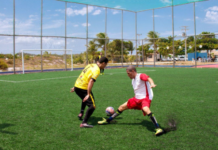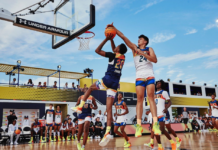Protective headgear may be on the way to becoming standard equipment in soccer. Virginia Tech researchers have tested 22 different padded headbands. The top-rated models reduced impact forces by 84% for impacts that simulate head-to-head collisions.
However, medical soccer experts are divided over the issue. Some say that laboratory data show that protective headgear reduces head injuries.
Reduce the Risk of Concussion
Soccer players might want to wear headgear because it can dramatically reduce the risk of concussion. But so far, there’s little scientific evidence that the equipment works.
A recent study by the University of Wisconsin found that protective headgear doesn’t result in fewer or less severe sport-related concussions than a group of high school players who didn’t wear the gear. The researchers tested head-to-head contact, one of the most common causes of concussion in soccer.
But while some medical soccer experts believe that headgear is necessary, others are skeptical. Still, some research indicates that the best headgear, like the Syzmik soccer concussion headband, significantly lowers a player’s concussion risks. Virginia Tech—considered the world’s preeminent lab for testing helmet safety—recently began including headgear in its tests and ratings.
Reduce the Risk of Head Injuries
Head injuries are a real concern in soccer. These injuries can result from blows to the head or from heading the ball. While there is no definitive evidence that protective headgear reduces the risk of concussion in soccer players, laboratory data suggests that these devices might lower the force of impact on the brain. Protective headgear, including padded headbands, has been on the market for years, but it hasn’t caught on in high school and college soccer, where players typically play without protective equipment.
Nevertheless, most medical experts do not recommend using protective headgear in soccer. They point out that there are many risks to the head from playing this sport and that no device can eliminate all injuries, including concussions. Furthermore, there is a fear that protective headgear will teach a “moral hazard” effect, giving players a false sense of invincibility and encouraging them to take greater physical risks on the field.
In addition, researchers note that some studies have found that protective headgear does not appear to be effective in reducing the incidence of self-reported concussions. One such study, conducted by Delaney et al., found that adolescent soccer players wearing protective headgear were no more likely to sustain SRCs than those not wearing headgear. Licensed athletic trainers working with the participants of this study recorded the occurrence of all SRCs, as well as symptoms and severity of the injury, electronically through REDCap.
Other research has shown that limiting contact during practices may reduce the risk of head trauma in young soccer players. However, this strategy is not foolproof and requires all athletes to wear appropriate protective equipment and to be supervised by an experienced medical professional.
Reduce the Risk of Other Injuries
A concussion can occur when your body or brain gets jostled enough to cause the brain to hit your skull. Often, these injuries come from direct contact with another player or as a result of falls and other mishaps. Some people think that headgear will prevent these injuries, but this isn’t necessarily true. Some studies have found that headgear may increase the risk of other injuries.
The protective headband will not eliminate the risk of concussion, but it will greatly reduce the amount of force transferred to the rest of the body from an impact. This will reduce the likelihood of injuries to other body parts, such as the neck, back, elbow, or shoulder. This will also decrease the chances of players colliding with one another, hitting the ground or the goalpost.
Some soccer purists fear that wearing headgear will give players a feeling of invincibility and encourage them to take more risks on the field.
One of the most common causes of concussions in soccer is heading the ball. While this activity is a key part of the game, it can also be dangerous. Researchers have found that, in general, it’s body-to-body contact rather than the force of a header that causes these injuries.
Nevertheless, some research has shown that helmets can help reduce the risk of head injuries when playing soccer. For example, a study at the University of Wisconsin found that while most helmets do little to reduce concussion rates, high-quality headgear significantly lowers them. In particular, top-rated helmets can reduce concussion risks by as much as 84 percent. The headgear debate is heating up, and some states are considering making it mandatory for all soccer players. The head injuries that can occur from heading the ball are serious and could leave young athletes with long-term brain damage, like CTE. Those types of injuries can ruin their lives, and it would be great if they didn’t have to suffer them in the first place.











